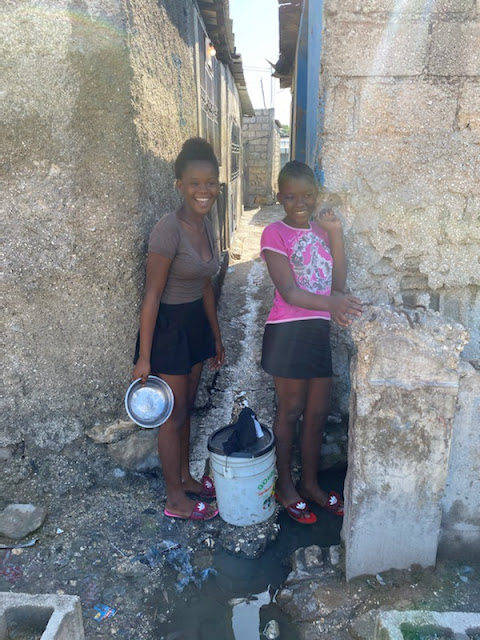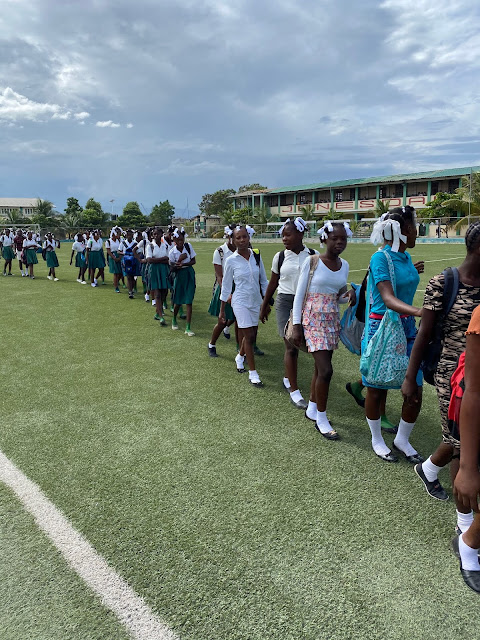John went to Haiti in November and had a good trip. Haiti means high mountains. Towards the end of John's trip, he traveled up the mountain in Port-au-Prince to visit Mr. & Mrs. Chenet Valcin. Above is the beautiful view from the vicinity of their home. ALL PHOTOS BY JOHN CARROLL
This is a bad news-good news-bad news story. Mr. Valcin has a serious heart problem. Bad news. But he has been accepted by an American medical center for heart surgery for free. Good news. But the American embassy has denied him a visa to the United States. Bad news.
John has been advocating for Mr. Valcin and has received emails from the U.S. ambassador and the U.S. consul general, both sympathizing with Mr. Valcin's position but more importantly saying that they will not grant him a visa. They won't tell us why they won't grant us a visa (this is confidential information) but we understand the reason to be that they do not think he would return to Haiti after his trip to the United States.
Mr. Valcin is married. He has children. He has a home. He has a job. He has a bank account. He has had a visa to the United States before and has returned. These are all reasons supporting the notion that Mr.Valcin would return to Haiti. He will die without surgery.
Despite all of this, the United States will not grant him a visa. The U.S. officials profess sadness about Mr. Valcin's situation. But despite this situation and the solution that we have, the officials say they can't violate the law. What kind of law is this? Does this not seem crazy?
I recently read an interview in Time with Heidi Schreck who said, referencing Justice Ginsberg, "Any approach to law that doesn't put the human being at the center, I'm suspicious of." I agree with this. Whatever law that the U.S. officials in Haiti are using to justify their refusal of Mr. Valcin a visa does not seem to care about him as a human being.

Market ladies selling their wares near Mr. Valcin's home.

One of the places that John often stays in Haiti is the Visa Lodge, a hotel not far from the airport. John, Luke, and I also stayed there for seven months when we were waiting for Luke's adoption to finalize in 2006-2007. Above is Innocent, from a photo the John took on his trip. Innocent also worked at the Visa Lodge in 2006.


Above is Anderson, a friend, visiting John at the Visa Lodge. Anderson has a ton of energy, smarts, and initiative.

Above is our friend and Haitian Hearts patient Heurese. We have known Heurese for almost 20 years. She has had multiple surgeries in the U.S. and has two children. She came to the Visa Lodge to pick up some medicines.

Here is John with the Honorable Herve Denis, the Haitian ambassador to the United States. We met Mr. Denis back in 2006 when we were in Haiti.

Beautiful flowers at the Visa Lodge.

Haiti is an island and it rains almost daily, though not necessarily like the torrent above.

Above is one of the maids at the Visa Lodge who was there back in 2006. Luke would help her make the beds in our room. We called her the Madam. After Luke's adoption was completed and we came home and were getting settled in, Luke asked me where the Madam was. I said, "You're looking at her, kid,"

Above is Pouchenie, a medical student who receives support from people in the United States. She stopped by the Visa Lodge for some medical tutorials from John. "She is so smart," he said.
Nothing like a Prestige at the end of the day. Great memories of that swimming pool.
Fort Dimanche was a notorious Haitian prison, where people were tortured and treated in other subhuman ways.
If anything could redeem a place like Fort Dimanche, it would be Mass. Father Tom Hagen celebrated Mass at Fr. Dimanche the first Sunday John was in Haiti.
Above is Father Tom, who is in charge of an organization called
Hands Together. Father Tom baptized Luke in Haiti in 2006.
John told me it was sweltering during the Mass.
Father Tom is a Salesian priest. Above in his home in Haiti are paintings of his order's patron St. Francis de Sales and also of St. Mother Teresa.
Father Tom's backyard.
The folks in the next few photos are from the neighborhood around Fort Dimanche.
The sign above says, No illegal guns but books, notebooks, pencils and pens.
Above are students from one of Father Hagen's schools
On many of his trips, John works at a clinic in a large Haitian slum called Cite Soleil. The clinic is run by the Daughters of Charity, an international order of Catholic sisters. On this trip, John got rides to the clinic by some of Father Tom's employees in Hands Together, which does a lot of work in Cite Soleil.
I'd like to think of a new word to replace slum. Who wants to say they live in a slum?
Look at this champ!
She's ready to learn.
A balancing act in the midst of . . .
Those eyes.
John said the poverty in Haiti is worse than COVID.
I want to see your face, Mama.
Hello world!




We talk a lot about basic services in Peoria: roads, garbage pickup, sewage, plumbing, electricity. All important.

On John's trips to Haiti, he would often see Pierre, below. Pierre is an artist who makes beautiful art out of scrap metal. Pierre sells his artwork to visitors to Haiti. With the pandemic and the political instability in Haiti, there haven't been many visitors, and Pierre hasn't been able to sell his artwork. On the last couple of trips, John brought back some Nativities, which sold out.
We have been happy to help Pierre. People love his work!

Above is a plate that Pierre made for me. Gradatim is a Latin word, which means "step by step." It was my Grandma's high school class motto and a good motto for Haiti and all of us.




















































Thank you for sharing these stories. I miss Haiti greatly.
ReplyDelete